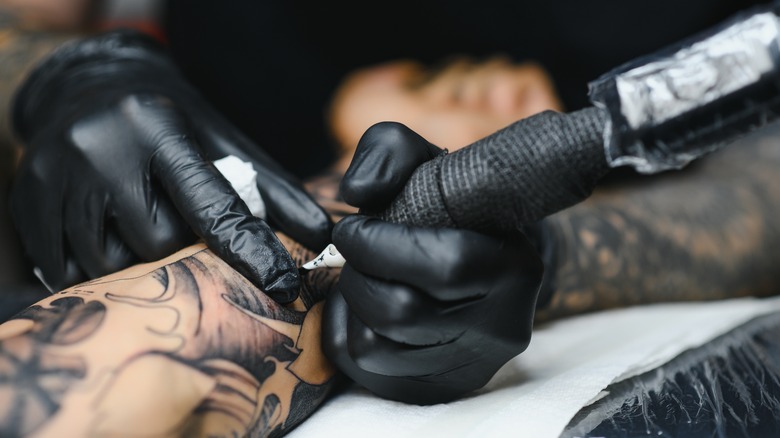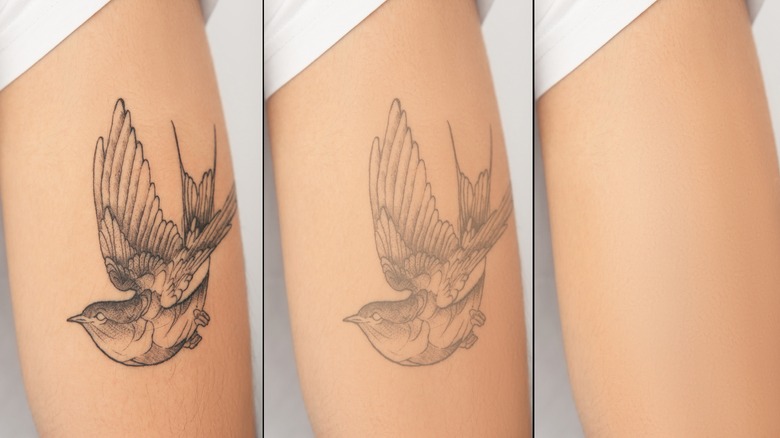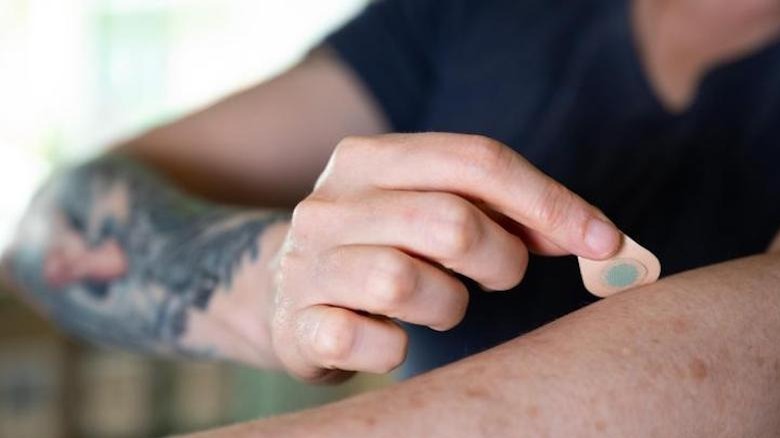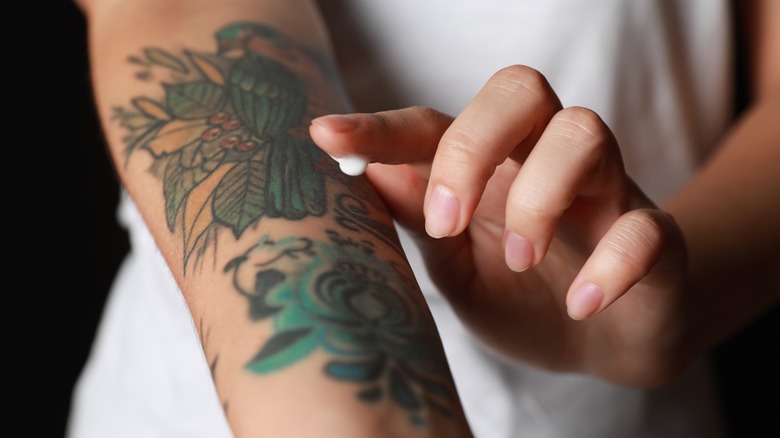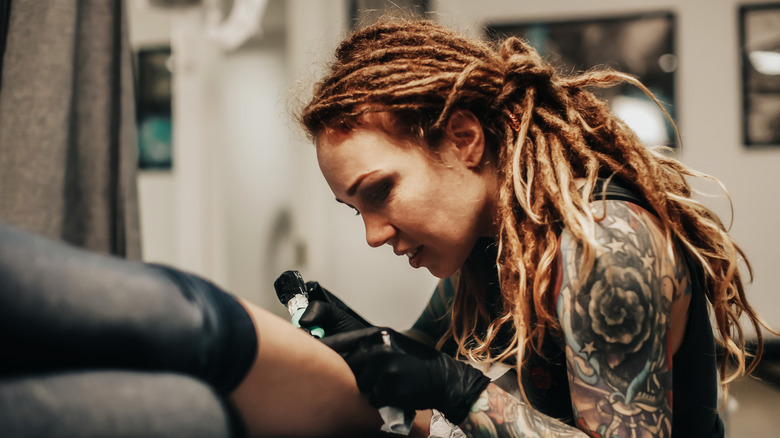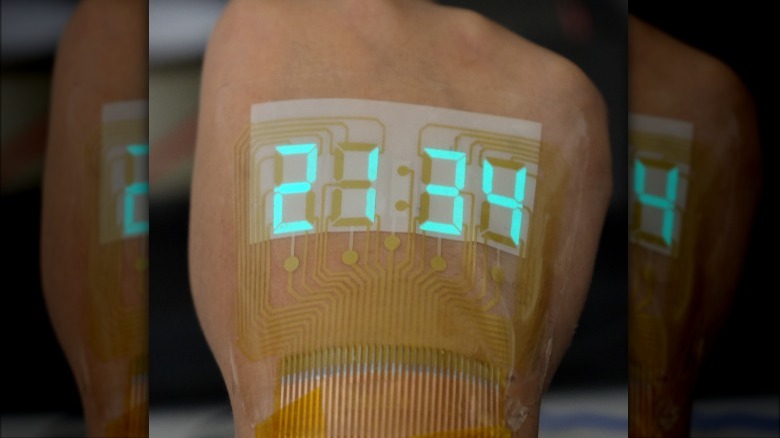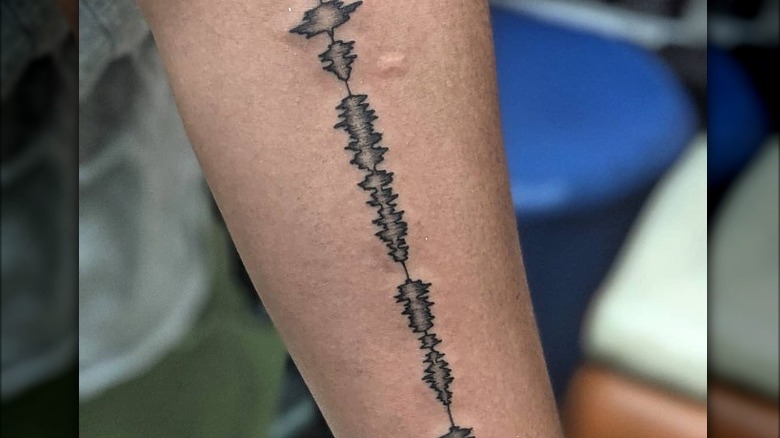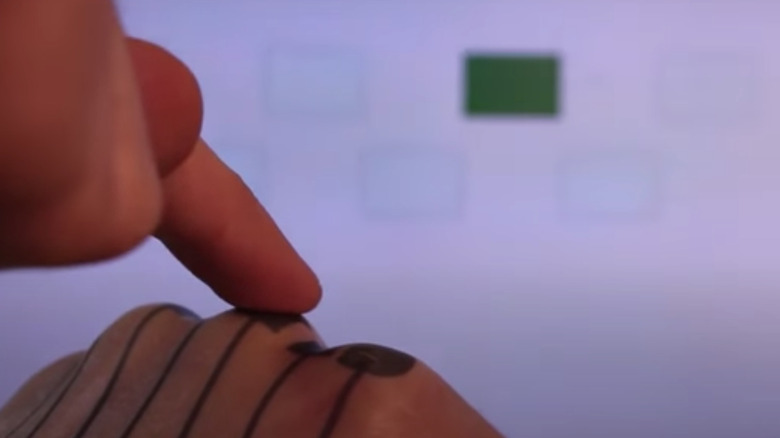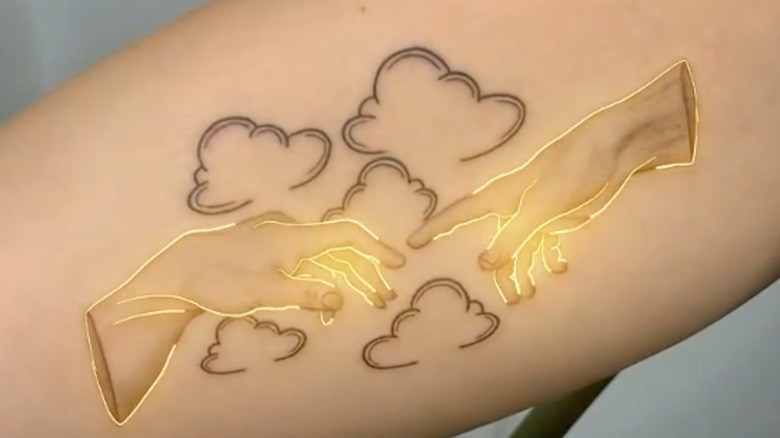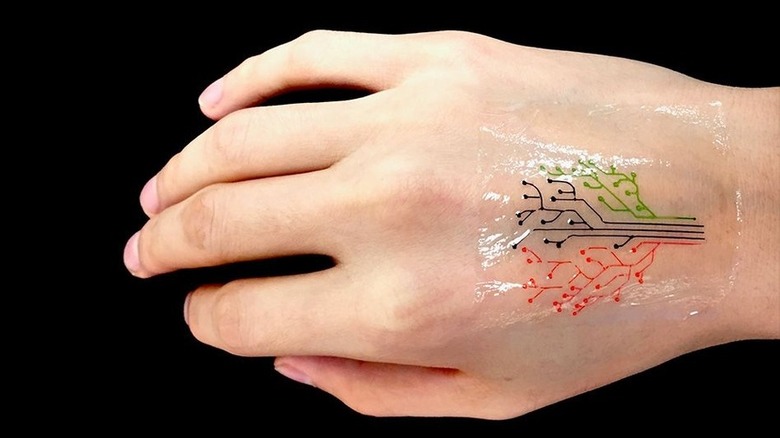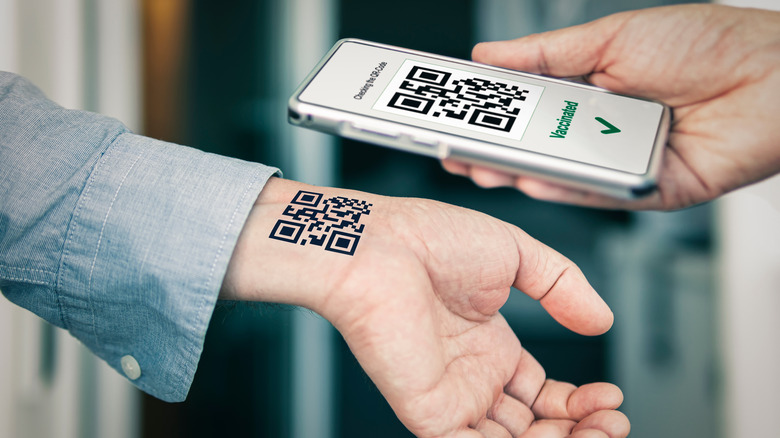The Most Incredible Tattoos That Feel Like They're From The Future
Since time immemorial, we humans have been using various pointed objects to jab ink into our skin. According to Smithsonian Magazine, the earliest anthropologic evidence of tattoos dates back to around 5,200 years ago. Since then, these body modifications have been used to indicate religion, tribal affiliation, status, or veteran status and wartime victories from ancient Roman civilizations up to the modern U.S. Navy.
In the 20th and 21st centuries, assumptions of tattooed individuals have slowly evolved beyond grizzled and hardened veterans. But it's not just public opinion that has matured over the decades — improvements in tattooing technology and ink came too, and many trends in tattoo style have floated in and out of popularity. That's why it's so hard to predict what the industry is capable of in the next 100, 50, or even 10 years, as innovative artists bring about hot trends and life-changing technology pushes the boundaries of what we know about tattoos.
Even so, there are many things happening in the world of tattoos that give us a glimpse of what the future may hold, including some fascinating overlap between body art, medicine, and even electrical conductivity.
Disappearing tattoos
Easily the biggest hangup people have on getting a tattoo is pretty obvious. Once you get one, there's no going back — or no easy way, at least. Ephemeral Tattoo came up with a solution for that; the brand calls it "made-to-fade ink," and it's a genuine tattoo — we mean needle-goes-in-skin, not a press-on — that will fade over time as its bio-degradable and bio-absorbable, medical grade, plant-based ink breaks down. The ink particles get smaller and smaller until they're tiny enough for your body to naturally remove them, Ephemeral says.
These disappearing tattoos will reportedly fade to nothing in nine to 15 months. A few factors will determine how long the process takes for you: tattoo design and placement, body response, skin tone, and aftercare. Disappearing tattoos may fade quicker on more melanated skin, and thick lines and shading will stick around longer than more delicate designs. Currently, made-to-fade tattoos are only available in black and white, but Ephemeral says more colors are in development. Ephemeral also has five studios across the country where made-to-fade tattoos are offered: New York City, Los Angeles, Atlanta, Houston, and San Francisco.
Are made-to-fade tattoos the future for people with commitment issues? There's not much information about how much this type of tattooing costs compared to traditional, but the ability to ink without regret surely is priceless.
Microneedle patch tattoos
Imagine if getting a tattoo was as easy as not only taking off a bandage, but putting one on. It could be possible someday in the future with research conducted by the Georgia Institute of Technology. The concept is called microneedle patches: You simply apply the patch over your desired tattoo placement area, and let the tiny needles do the rest of the work. The needles, which are smaller than grains of sand and made of tattoo ink themselves, are arranged in the pattern of the tattoo. They puncture the skin and then dissolve to deposit the ink they're made of. But because they're so small, it's not noticeable. No pain, no bleeding.
According to Georgia Tech, these innovative tattoos are helpful even outside of cosmetic body art. They could also be used for animal tagging and tracking or medical alerts, like epilepsy or diabetes. The concept could be applied to painless administration of vaccines instead of hypodermic needles, GA Tech says, and the microneedle patches reportedly come with a lower risk of infection than traditional needles.
Robot tattoo artists
Would you trust a machine to make permanent alterations to your skin? Robot and AI tattoo artists very well could await us in the future of tattooing, because it's already happening now. In a T-Mobile marketing campaign for 5G called The Impossible Tattoo, a tech expert and a tattoo artist teamed up to engineer a machine-learning, 5G-driven robotic arm that the tattooist used to tattoo someone remotely (via PC Magazine).
There's a lot to be wary of when it comes to robotic tattooers — what's stopping this thing from stabbing straight down to the bone? — but at least you aren't being pressured to make conversation with your artist while white-knuckling through the pain. Robotic tattooers are also steadier than humans, The Verge says, but the interview in PC Mag points out the significance of a tattoo being an exchange between two humans, especially with the one administering being able to feel out the terrain of the other's skin. Who knows when machine tattooers will take off or how far they will get.
Dermal Abyss tattoo ink
People who need to monitor their blood glucose levels, sodium intake, or other important biomedical data currently rely on wearable medical devices to tell them when something is wrong, but the future of tattoos may serve to benefit those with diabetes or other conditions that require constant monitoring. A collaborative effort between Harvard University and MIT discovered that biologically reactive ink can be used in a traditional tattooing environment.
The tattoo ink, called Dermal Abyss, changes color in response to chemical levels in interstitial fluid, explains The Harvard Gazette. This could be blood sugar to indicate a need for insulin, or sodium levels to indicate dehydration. The Gazette suggests it could even monitor vitals for astronauts, which demonstrates the boundless applications the ink could have should it ever become widely accepted in the medical community. While Dermal Abyss was only developed for research purposes (via MIT), the implications for the future of tattooing and its place in medicine are significant.
Electroluminescent tattoos
Cyborgs are pretty firmly implanted in science fiction and pop culture. We're probably not looking at any "I, Robot" or "Metallo the Brain" scenarios anytime soon, but you could take yourself one teensy-tiny step closer to cyborgism with a temporary tattoo that serves as an alternating-current electroluminescent (ACEL) display. According to a report published by the American Chemical Society, these temporary tattoos are elastic and flexible enough to comfortably conform to the skin without warping the lights' display.
Don't worry: The voltage of this gadget is too low to cause any injury to your skin. This technology may not be advanced enough to be embedded in the skin like a traditional tattoo, but even as a short-term body modification, it has tons of practical applications, the Society explains. The ACEL display in this specific report is configured as a stopwatch, which holds a ton of appeal for athletes, but who knows where this development in human-and-machine interfacing could shoot off to.
Skin Motion soundwave tattoos
Is there a snippet of audio that means the world to you? Something that's latched on to a memory? It could be the audio from a home video, or maybe you've held on to the last voicemail of a loved one who's passed away. This pictured futuristic tattoo is brought to you by Skin Motion, a company that hopes to transform that meaningful snippet into a visual display of sound waves.
This tat isn't just a memorial to look at, though. Skin Motion offered a Soundwave Tattoos mobile app that could play back the audio any time you scan it with a mobile phone. There are quite a few contingencies to the tattoo: You can't tattoo it on a part of the body that curves around, thick body hair will affect how well the app scanning works, the app requires a subscription purchase, the site is pretty mum about how well it would work on Black and Brown skin tones, it's not recommended to get a Soundwave tattoo longer than six inches, and it's not recommended to use commercially-produced music. Still, we think it's indicative of how digital integration and interaction with body art may evolve in the future.
Note: As of November 14, 2022, Skin Motion has paused operations indefinitely due to technical difficulties. It remains to be seen if this technology will evolve in the future.
Tattoos that alert you to UV exposure
Who hasn't enjoy a good, long bask in the sun every now and again? No one can deny how pleasant feeling the warmth of sunshine is, but increased awareness over time of the harms of prolonged UV exposure and best practices of skin cancer prevention have made us more conscious of our suntanning habits. Sunscreen is, of course, one of the most widely-recommended ways to stay protected from overexposure, but it can be tough to remember when to reapply, especially if you're lazing it up at the beach or enjoying a hike. A tattoo created by the University of Colorado aims to help us remember when to bust out the SPF 50 for a fresh coat.
According to a report by Inked Magazine, the tattoos contain a dye that is invisible during periods of low or absent UV exposure, but turns blue when you've been under the sun's rays for too long. The idea behind the tattoo is that, if you can see it, it's time to reapply sunscreen, or better yet, head indoors. The areas most susceptible to skin cancer are the face, neck, hands, and arms (via the CDC), and while we aren't necessarily endorsing a face tattoo, this would be a great thing to have on one of the areas exposed to UV light the most — like the hand or outer wrist — to know when your UV exposure levels are getting high.
SkinMarks biological touchpads
Someday in the future, you may never have to argue with your family about who lost the television remote ever again. That's thanks to SkinMarks, a remarkably innovative temporary tattoo that turns its wearer into an interview touchpad surface of buttons and controls. The research of this futuristic tech has even been funded by Google, according to a Saarland University white paper.
The developers made the temporary tattoos thin and flexible to be able to follow the body's natural contours, namely the hands, fingers, and knuckles, where a simple tactile movement like a certain tap or bend could be all it takes to initiate some sort of remote command. Saarland refers to this emerging technology as "epidermal electronics," and while it could certainly make life significantly more convenient for the masses someday — like turning up the volume without lifting a finger, but perhaps bending a knuckle — we think the potential for bringing access to the disabled population is significant.
Tattoos animated with neon lights
Okay, so these are actually just normal (albeit very well done) tattoos, and it's the animations that make them look futuristic, but they're straight out of the year 3000 nonetheless, and we can dream, right? Maxim Sipakov, a 20-year-old animator from Russia, turns regular tattoos into dazzlingly illuminated works of art by adding moving neon light animations. The effect is incredible to observe in Sipakov's Instagram videos, where the neon glow ripples and flashes across a tattoo's lines, giving it the illusion of movement.
Sipakov has added kinetic and vibrant animations to mandalas, plants and animals, and even portraits. He's put his digital flair on art from tattooers that come from all over the world, according to Inked Magazine. Right now, Sipakov's creations are just products of his imagination, but maybe someday in the distant future, we'll be walking around lit up like a dive bar wall.
Living tattoos from MIT
The art and science of 3D printing have come a long way. We've seen the world's first 3D-printed eye, a 3D-printed version of beef, and countless other creations that were unfathomable even just a decade ago. We are quite morbidly curious about what the future world of 3D printing looks like — probably things that only science fiction authors could dream up right now — but the worlds of 3D printing and tattoos are likely to collide.
Engineers from MIT 3D-printed a tattoo made from a very unique and new kind of ink that's alive ... sort of. MIT calls it the "living tattoo" on account of the living bacterial cells that are used in the ink. The cells are biochemically programmed to respond to the presence of different chemicals and compounds, the MIT report says. Each "branch" of the tree-shaped tattoo is reactive to a different substance and will light up in color if that substance is detected on the skin.
Working QR codes and barcodes
You really can't miss QR codes in the modern day. They seemed to really take flight as a way to give paperless menus to diners during the pandemic, but since then, we've seen them on boarding passes, educational materials, and apparently tombstones. All QR codes do is store data that is read and translated by a smartphone, but if you're ... super passionate about that data, you could get its QR code tattooed on your body. And if the tattoo is done properly, the QR code should be functional, meaning anybody can scan it to read its data. You could lure innocent bystanders into a RickRolling, commemorate social media profiles, or even ink a permanent link to your COVID vaccine (via Vice). That'd be a fun one to explain in a few decades!
Digitally interactive tattoos are certainly an emerging trend of the future, but there are definitely some risks associated with QR code tattoos. The information you're linking to could be removed or expire, or scarring, bleeding, and fading could render your QR code ineffective (every single drop of ink matters very much in a QR code tattoo, since it's representing a specific matrix of data molecules), so then you have to explain every time someone sees it that it doesn't work.
Graphene tattoos
If at some point in the future you see someone walking around with a strange, geometric, almost-transparent gray tattoo, it may be made of graphene. Tattoos made of graphene are ultra-thin, electrically conductive, and can adhere to the skin with just water, according to a research paper published in the American Chemical Society Nano Journal. The tattoos are temporary but their electrical and biological compatibility makes them perfect candidates for the future of medical wearable technology.
They may not look like much as traditional body art, but these graphene tattoos can help monitor important electrical activity in the body, particularly in the heart and brain. The tattoos are flexible enough to follow the skin's topography, making it more accurate of a biological monitor than traditional devices, the report says. Just the fact that these tattoos are only a few hundred nanometers in thickness feels futuristic enough for us.
